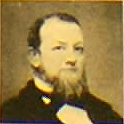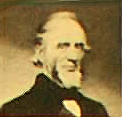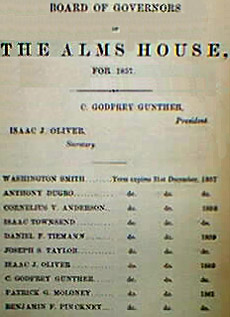Even before he was old enough to vote, C. Godfrey Gunther took part in Democrat political action. He became such a familiar figure at party rallies that his playing a leading role in the Manhattan torchlight parade promoting the 1844 Presidential candidacy of James K. Polk against Whig nominee Henry Clay was readily accepted. It was the first election in which Charles could vote. His energetic efforts on behalf of the Polk candidacy were appropriately noted by the Democratic hierarchy in New York. Charles was selected for membership on the Young Men's Democratic General Committee. Years later he became its chairman.
An advocate of American expansionism (aka "manifest destiny"), Polk strongly favored re-annexation of Texas and re-occupation of Oregon. Campaigning with the slogan "Fifty-Four Forty or Fight," Polk resoundingly won the White House. Quite aside from any personal ambition that the young man had to advance in the city's dominant political party, Gunther's own economic interests fit well with the Polk expansionist policies. From the age of 16, Charles had worked in the family mercantile firm of C. C. Gunther & Company, comprising his father and brothers. As America grew, so did the business.
Despite the demands on him by the family firm and politics, young Gunther found opportunity to marry, travel in Europe and begin his own family that eventually grew to include four children. By the time the next successful Democratic Presidential campaign took place -- the 1852 contest of Franklin Pierce vs. Whig candidate Winfield Scott -- Charles had gained recognition as a likely future leader in the local party. Earlier that same year he chaired the organizational meeting for formation of a Young Men's Democratic Union Club. His work on behalf of the Pierce candidacy further added to Charles' standing.
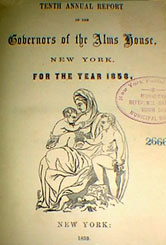
|
|
Year after year, the annual reports of the Alms House Governors featured on their title pages an image of Municipal Mother succoring and comforting her children. When the Dept. of Public Charity and Correction succeeded the board, the DOPCC continued to use the same Municipal Mother image on its annual report title pages.
|
General Scott's thorough trouncing by the Democrats ("First we Polk-ed you, now we Pierce you") signaled the decline of the Whigs as a political force nationally. That development, in combination with Pierce's pro-slavery administration (which included Jefferson Davis), led to the eventual emergence of the Republicans, the party of Lincoln.
The slavery issue also impacted relationships within the New York Democratic Party. So-called radical Democrats opposed extending slavery into the new territories as the country expanded. These Free Soilers were derisively tagged Barnburners and later Softshells. Taking issue with them were anti-abolitionist Democrats who opposed agitation over the slavery question. They argued that Free Soilism imperiled New York's economy so dependent on Southern trade, and therefore also jeopardized city political officeholders' jobs. These partisans were first called Hunkers, later Hardshells and still later Copperheads and Peace Democrats.
In 1853, James T. Brady, who had been a leading Hunker/Hardshell, resigned as president of the Young Men's Democratic Union Club. Gunther was elected his successor, but only after a very spirited -- indeed bitter -- contest. His victory as a Hardshell was short-lived. A week later the Softshells rallied to adopt resolutions condemning the club vote, prompting Gunther to resign and to help organize a new group calling itself the Democratic Young Men's National Club. Brady became its president and Gunther, its vice-president.

|
|
Peter Cooper, founder of Cooper Union for the Advancement of Science and Art, was uncle-in-law of Daniel F. Tiemann, an almshouse governor who became mayor as did Gunther later. Tiemann was a Cooper Union founding trustee.
|
The following year, the Hardshells held a convention in which they nominated Gunther as their candidate for the then-elective office of Alms-House Governor. However, the Softshells nominated Daniel F. Tiemann, who was married to the niece of the city's leading philanthropist Peter Cooper, founder of Cooper Union. The niece, Martha Clowes, was the daughter of his wife's sister but the girl's parents, Mary Bedell and Benjamin Clowes, died. Cooper raised the orphaned in-law in his home as if she were another daughter of his. Her wedding to Tiemann was held in the Cooper home in 1826. Practically speaking, Tiemann's relationship to Cooper was closer to that of son-in-law than the more distant-sounding but valid title "nephew-in-law" would imply.
Tiemann won the Alms-House post that election but Gunther, even in defeat, had shown strong vote-pulling power, running well ahead of most other candidates on his ticket. The next year, 1855, Gunther was again nominated for Alms-House Governor and this time won handily, again running thousands of votes ahead of the rest of the ticket.
The 1854-elected Alms-House Governor Tiemann would go on to be elected mayor in 1857, the same year that the 1855-elected Alms-House Governor Gunther would become president of the Alms-House Board of Governors.
That members of the Alms-House Department Board of Governors were elected to their positions overseeing the operation of municipal correction and charitable institutions may seem strange to the current generation of New Yorkers. We are used to having such positions filled by mayoral appointees. But back then the electoral process seemed a very sensible approach, especially since many of the people going to or being sent to those institutions came from immigrant communities whose voters were increasing in number and therefore increasing in political impact. In that era, German was the foreign language most spoken in New York City and the German-heritage community constituted one of its largest voting blocs.
The linkage of the New York City's charitable and correctional institutions in their governance can be traced back to the emergence of the city freed from British control at the de facto end of the Revolutionary War. Not long after the Redcoats' evacuation on Nov. 25, 1783, the citizenry went about establishing a new municipal government. As part of that process, the posts of Commissioners of the Alms-House and Bridewell were established in 1784. The Bridewell was the name of a city jail. The first Bridewell was built in 1734; the second, in 1775 next to City Hall.
Prior to 1784, the Alms-House and Bridewell had been under the direct charge of the mayor, recorder (judge) and aldermen. But the complexity of the governmental challenge facing these city officials in the post-Revolutionary War period prompted them to delegate immediate management of such institutions to those filling the newly-created positions of Alms-House and Bridewell Commissioners.
In 1811, construction of new almshouse facilities began on an East River shore site known as Bellevue. Three years after that start, the plans were enlarged to include a penitentiary with “a complete system of manufactories.” To facilitate the undertaking, the state legislature on April 15, 1814, granted the Common Council’s request to have one of the Bellevue buildings designated as “The Penitentiary of the City of New York.”
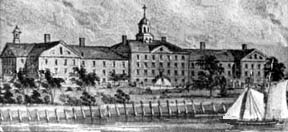
|
|
An early Bellevue complex scene on the East River.
|
By a legislative act in 1816, the commissioners in charge of the Almshouse and Bridewell were formally given control over the Bellevue Penitentiary as well (although they had been exercising it de facto). About 10 years later the hospital we now identify with the name Bellevue was built and the entire complex enclosed with a stonewall.
During the spring of 1828, New York City purchased the property in Greenwich Village that had served as the state's first prison (Newgate). The city planned to use the facility to house its own inmates, including those from its own Penitentiary at Bellevue. But the Common Council changed course in July of 1828 and instead purchased Blackwell’s Island for that purpose.
The Alms-House Department in 1832, the same year as its establishment (April 23), oversaw on Blackwell's the construction of the planned "new" Penitentiary's main building. The Department was run by five non-paid Commissioners appointed by the Common Council.
The massive edifice of granite, originally named "The Halls of Justice" but soon known as "The Tombs," was built under Alms-House Department direction, between 1835 and 1840, on a huge square-ish plot bounded by Centre, Elm, Franklin and Leonard streets. Its nickname derived from its design inspired by an ancient mausoleum in Egypt. Some Tombs granite came from old Bridewell in City Hall Park. In 1845, the five unpaid Alms-House commissioners were replaced by a single commissioner, that official being chosen by the voters each May 1.
Four years later, the State Legislature again changed the Alms-House Department governance, creating a 10-member board of governors, each with five-year terms, two board seats being filled by action of the general electorate each January.
In 1852 the Alms-House Department saw to construction of a workhouse on Blackwell's to replace an old similar facility at Bellevue. The workhouse functioned as an institution for punishment of petty violators, many of whom were classified as habitual "drunks and disorderlies."

|
|
The Penitentiary on Blackwell's Island.
|
In 1858, the year after Gunther had become Alms-House governors board president, the north wing was added to the Blackwell's Penitentiary.
Besides the Penitentiary, the Alms-House Department at that time also counted among its facilities of a correctional character the Tombs, the Blackwell's Island Workhouse, the Jefferson Market Prison, 10th St. and 6th Ave., Greenwich Village, and the Essex Market Prison, 1st & 2nd Sts. and 2nd Ave. The latter later became known, respectively, as the Second and Third District Prisons. Its other facilities included Bellevue Hospitals, the Small Pox Hospital, the Lunatic Asylum, Blackwell's Island Hospital, the Colored Home, the Colored Orphan Asylum, and the Nursery Hospital.
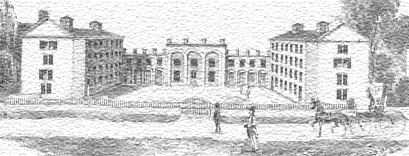
|
|
Situated on 1st Ave. between 64th and 65th Sts., the Colored Home for sick, aged and poor blacks was one of the Alms-House Department facilities.
|
The system of electing the 10 Alms-House Department governors continued until 1860 when that agency was replaced by the Department of Public Charities and Correction (DOPCC) run by four commissioners appointed by the City Comptroller.
By 1871, the number of DOPCC commissioners had increased to five, all appointed by the mayor. Two years later, a new state law mandated that the department establish two separate bureaus, one for correctional facilities and the other for charitable institutions. In 1895 the dual department was divided into two separate departments along those bureau lines: the Department of Correction and the Department of Public Charities (later to be known as the Department of Welfare). Their commissioners were mayoral appointees.
Thus, the New York City Department of Correction of 2001 correctly dates its list of commissioners from the December 21, 1895 appointment of Robert J. Wright who headed the agency when it separated from Public Charities and began operating as its own entity Jan. 1, 1896. But any album of what might be called its family tree -- its governmental genealogy, if that term be permitted -- needs to reserve some room for recognizing the commissioners and governors who headed NYCDOC's ancestor agencies, including the Alms-House Department from whose board two mayors emerged.
